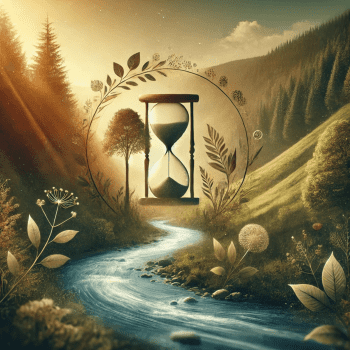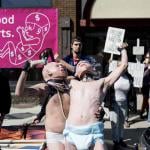Our age is retrospective. It builds the sepulchres of the fathers. It writes biographies, histories, and criticism. The foregoing generations beheld God and nature face to face; we, through their eyes. Why should not we also enjoy an original relation to the universe? Why should not we have a poetry and philosophy of insight and not of tradition, and a religion by revelation to us, and not the history of theirs? …why should we grope among the dry bones of the past, or put the living generation into masquerade out of its faded wardrobe? The sun shines to-day also. There is more wool and flax in the fields. There are new lands, new men, new thoughts. Let us demand our own works and laws and worship.
—Ralph Waldo Emerson, “Nature” (1836)

A few weeks ago, my wife Magin and I were on our way to see the film Lincoln , and we unexpectedly found a large crowd gathered around a brightly decorated tree in front of the theater. There was free hot chocolate, costumed-characters, and a dance troupe. We came to discover that we had unintentionally stumbled upon the annual tree lighting. Keep in mind that, at this point, Thanksgiving Day was almost a week ahead of us. I turned to Magin and said, “Looks like Christmas is here — ready or not.”
To satisfy my own curiosity, I googled this event, and discovered that the official title is the “Tree Lighting Ceremony.” So technically “Christmas” is not in the title. And upon closer examination of the tree itself, there were no distinctly Christian ornaments, for better or worse — only candy, wrapped packages, colored baubles, and gingerbread figures. On one hand, I appreciate the festivity of seasonal decorations. On the other hand, I recognize that exclusively promoting Christmas during the holiday season can be unwelcoming to non-Christians. And even for many people who find the Christian tradition meaningful, the increasingly early, ubiquitous, and commercialized presence of Christmas is troubling.
Rewinding to even earlier in November, with Halloween barely passed, Magin and I made a similar trip to see the film Argo. As we strolled from our car to the theater, we found the sounds of Christmas carols surrounding us from the loudspeakers. Magin and I both enjoy holiday music, but as a friend commented on Facebook recently, “I like all the holidays. I just like them one at a time.”
Those of you who have been following the debates in recent years about the so-called “War on Christmas” know that navigating the holiday season becomes markedly more complex when you move from the freedom of private property such a shopping mall to public property. And one of the opening skirmishes in this year’s holiday season is happening in Santa Monica, California. According to The Washington Post, a few days after Magin and I stumbled upon that tree lighting,
A federal judge…denied a bid by churches to force city officials in Santa Monica, California to reopen spaces in a city park to private displays, including life-sized Christmas Nativity scenes. The city shut down the six-decade tradition last year after a bitter dispute between religious groups and atheists, who overwhelmed the city’s auction process for display sites, winning most of the 21 slots…. In last year’s struggle, the secular groups got the right to use 18 stalls at Palisades Park, while two stalls went to traditional Christmas displays and one to a Chanukah display…. The atheist groups used their stalls to put up signs referring to religion as a myth or comparing Santa Claus to the devil. Most of the signs were vandalized in the ensuing uproar.
Whether you agree or disagree with the results, the approach of the atheists in Santa Monica is strategically savvy. As one commentator said: “In recent years, the tactic of many in the atheist community has been, if you can’t beat them, join them. If these church groups insist that these public spaces are going to be dominated by a Christian message, we’ll just get in the game — and that changes everything.”
A similar battle has been playing out in Leesburg, Virginia. There, the “if you can’t beat them, join them” tactics have seen Crèches, Chanukah menorot, and Christmas trees joined with Star Wars displays (from those who says their religion is Jediism) as well as tributes from the self-described Pastafarians from the Church of the Flying Spaghetti Monster. This satirical religion was founded in 2005 to help stymy debates that “Intelligent Design” should be given equal time in public school science curricula. Pastafarians proposed, “One third time for Intelligent Design, one third time for Flying Spaghetti Monsterism…and one third time for logical conjecture based on overwhelming observable evidence.”
Even more controversially, some of you may recall that last year a life-sized, crucified skeleton in a Santa costume was put on the grounds of the Loudoun County courthouse in Leesburg. The claimed intent was “to depict society’s materialistic obsessions and addictions and how it is killing the peace, love, joy and kindness that is supposed to be prevalent during the holiday season.” I suspect you can imagine the uproar and offense that many experienced at that sight. Admittedly that crucified skeleton Santa was the work of one rouge citizen, but a similar statement was presumably being made this past Friday when, around 3:00 p.m., an artist “set off a series of explosions in a 40-foot Christmas tree in front of the Freer and Sackler Galleries” on the National Mall. (This piece of performance art was announced in advance, so Homeland Security did not descend upon the scene!)
Along the lines of these protests, I do think that many religious people fail to appreciate the offense that segments of our population experience regularly when they see the widespread celebration of what seems to them to be antiquated superstition. The ongoing rejection of science by many religious groups further compounds this frustration. So there is a sense in which I can see the justification for having a holiday display, such as has occurred in Leesburg, in which secular humanists read publicly from Darwin’s Origin of the Species to show an alternate perspective to the nearby Christian group reading from the Gospel of Luke. In this spirit, Carl Sagan has, in all earnestness, said, “A religion that stressed the magnificence of the universe as revealed by modern science might be able to draw forth reserve of reverence and awe hardly tapped by the conventional faiths.” So, just as the lighting of the Yule log on Winter Solstice celebrates that daylight will now start growing incrementally longer and just as Christmas celebrates of the light revealed in the life of Jesus, so too the reading of scientific texts can be a celebration of Enlightenment knowledge that brings the light of scientific truth to this world.
And taking all the competing interests in our society into account, the only option I can see to pluralistic public square is a naked public square. And although I am sympathetic to the argument for a naked public square, I’m not convinced that we should give up on the possibility of a healthy, robust pluralism. After all, the most vibrant, fertile ecosystems are not monocultures or barren landscapes, but those that are teeming with diverse forms of life.
And in reflecting on how all these diverse holiday interest groups compete for attention in the public square, I was particularly struck by a quote from the situation described earlier in Santa Monica in which a man wanted only Christian nativity scenes on the city’s public property. He said, “It’s a sad, sad commentary on the attitudes of the day that a nearly 60-year-old Christmas tradition is now having to hunt for a home.” I thought, is that all it takes? Is 60-years all that is needed to craft a venerable tradition?
There may be a 60-year-old tradition in Santa Monica of displaying Nativity Scenes in public spaces, and there may be a much longer tradition of displaying Christmas trees, but continue to turn back the clock of history, and — as many of you know — you’ll discover that a Christmas tree is simply a Yule Tree that Christians “baptized,” so to speak, and renamed a “Christmas Tree.” From this perspective we could protest that the alleged “War on Christmas” is a cover-up for the “War on Yule!”
We also need to be honest that what compels most retailers to pump out carols over their loudspeakers the day after Halloween and to put up Christmas decorations in the weeks before Thanksgiving has as much to do with anxiety about ending the year in the black as it does celebrating Jesus’ birthday. As I once heard an NPR commentator say, “Jesus was not born to be the patron saint of fourth-quarter earnings.”
In the Christmas rush to buy presents, we can forget that the historical Jesus was an itinerant peasant, who warned about the dangers of wealth. And the original St. Nick brought presents not for everyone, but for poor children. Fortunately, there are increasing numbers of individuals and groups, who are seeking to reclaim a more authentic Christmas celebration by emphasizing charity and social justice during the holiday season.
But this morning, given that Unitarian Universalism draws from all of the world religions (not only from the Christian tradition), there is an additional response to the holiday status quo that I would like to invite us to explore. Instead of being limited to the traditions of the past, what would it look like to intentionally craft our own rituals that both draw from the best of past tradition and that also seek to be relevant to our twenty-first century context? We are no less capable of founding a lasting tradition than were our ancestors. Yule, Christmas, and Chanukah all started somewhere, and there was a time when each did not yet exist. As Emerson challenged us, “why should we grope among the dry bones of the past, or put the living generation into masquerade out of its faded wardrobe? The sun shines to-day also. There is more wool and flax in the fields. There are new lands, new men, new thoughts. Let us demand our own works and laws and worship.”
I have a longstanding interest in the question of how religious traditions become invested with meaning and authority. Many of us here today grew up with holiday rituals, songs, and foods. And those seasonal traditions have a special resonance since we first experienced them at a young, impressionable age. And that special resonance can continue — sometimes against our will— even as we become adults and perhaps question the theology and history espoused by some of those traditional celebrations. So an invitation is to consider how we might craft an equally meaningful set of traditions for ourselves and future generations.
Admittedly, establishing new traditions is difficult work, and takes time. Catherine Bell is a ritual scholar, who has studied this process. She writes, “There is increased pressure for the invented rite to show that it “works”; that is what legitimates the rite since there is no tradition to do this. Of course, the expectations of what it means to work are also not the same as for traditional rituals, for which one asked not whether the rite worked, just whether it was done correctly.”
I suspect many of you have experienced sitting through a tradition that is devoid of meaning for you, but that is being done for the sake of tradition alone — allegedly “because we’ve always done it that way,” even though we know that if you go back far enough in history, you’ll find that we have not always done it any way. And one of the best parts of Unitarian Universalism is that our congregational life together is not constrained by a “Book of Worship” or a “Book of Order.” We have tremendous freedom to cut ties from words and rituals from the past that have become burdensome, meaningless, or oppressive. But this freedom to innovate can simultaneously leave us bereft of any grounding in historical tradition.
To share with you an example from my life of being intentional about ritual, Magin was raised in the Reform Jewish tradition, and I was raised in a Christian tradition. One of the reasons our interfaith marriage never presented a problem for us is that, from the beginning of our relationship, we both viewed our respective religious traditions as equally legitimate paths. But there is significant pressure in many Jewish circles not to have a Christmas Tree based in the understandable anxiety that Christmas will overshadow Chanukah or that Christianity will consume Judaism, especially give the dominance of Christianity in many parts of this country. But one reason we are grateful to be Unitarian Universalists is the encouragement to take the conjunctive path of “both/and” religion instead of limiting your options to either one tradition or the other. So this year, we have a Christmas tree, decorated with family heirloom ornaments, and we will also light our Chanukiah, the menorah used for the eight nights of Chanukah. We sometimes joke about celebrating not just Christmas or Chanukah, but “Chrismukah”! And harkening back to Yule, Magin and I love the tradition of lighting candles and of having a Christmas tree to help brighten the night on these increasingly short days as we move toward Solstice, the longest night of the year.
To take one step further down the road of new holiday rituals, how you have ever heard of Chalica? Chalica — spelled liked the word Chalice, but with an “a” at the end — came from a group of Unitarian Universalists wondering what it might look like to create a new UU holiday. And just as the venerable traditions of Yule, Christmas, and Chanukah all had a historical starting point, the first Chalica celebration was in 2005.
The first day of Chalica is always the first Monday in December. The festivities continue for seven days with a focus each day on one of the Seven Principles of Unitarian Universalism. And since UUism is more about “deeds than creeds,” the idea is to not only focus on the meaning of that day’s principle, but also to do an action to live out that principle. This fledgling holiday is still in its infancy, but there is already a Chalica Facebook page, a Chalica blog, and even original Chalica-themed songs on YouTube.
If you have time, I encourage you to listen to this original Chalica song (it’s a little less than 4 minutes long):
https://www.youtube.com/watch?v=S5zoFZ0rNSE
But the larger point is to consider celebrating a week each year in which UUs focus each day on one of the Seven Principles and take an action to embody our principles. Perhaps you’ll consider spending one week this December celebrating Chalica, and lighting either a Chalice or a candle each night to share with your friends or family how you have learned about or practiced the UU principle of the day.
Ultimately, though, my hope for you this holiday season — whether you are celebrating science, Chalica, Chrismukah, or the Church of the Flying Spaghetti Monster — is that you find a meaningful way to cultivate peace, hope, joy, and love in the days and weeks to come. And I wish you all Seasons Greetings, Happy Holidays, and Joyous Chalica!
Notes
1 For an example of Christians finding an increasingly commercialized Christmas troubling, see Mark Sandlin, “War On Christmas? Sign This Minister Up!” (November 30, 2012), available at http://sojo.net/blogs/2012/11/30/war-christmas-sign-minister.
2 All of the quotes related to the Santa Monica case are from Doug Stanglin, Religion News Service, “Judge blocks holiday displays in Santa Monica after atheist-Christian spat” in The Washington Post (November 20, 2012), available at http://www.washingtonpost.com/national/on-faith/judge-blocks-holiday-displays-in-santa-monica-after-atheist-christian-spat/2012/11/20/e545b1c4-334c-11e2-92f0-496af208bf23_story.html.
3 Caitlin Gibson, “Crucified skeleton Santa sparks controversy in Loudoun” (December 6, 2011), available at http://www.washingtonpost.com/blogs/post_now/post/crucified-skeleton-santa-sparks-controversy-in-loudoun/2011/12/06/gIQAMIcxZO_blog.html. See also, “Atheists plan attended holiday display in Leesburg” (November 14, 2012), available at http://www.washingtonpost.com/local/atheists-plan-attended-holiday-display-in-leesburg/2012/11/13/a5df0e8a-2db7-11e2-89d4-040c9330702a_story.html.
4 On the origins of the Church of the Flying Spaghetti Monster, see http://www.venganza.org/about/open-letter/.
5 Maura Judkis, “Video: Christmas tree on Mall goes up in smoke” (November 30, 2012), available at http://www.washingtonpost.com/blogs/going-out-gurus/post/heres-what-that-exploding-tree-on-the-mall-looked-like/2012/11/30/4c5bf464-3b30-11e2-a263-f0ebffed2f15_blog.html.
6 John Boykin argued on National Public Radio that Jesus “was not born to be the patron saint of fourth-quarter earnings.” I could not find a link to the original broadcast.
7 More about the historical St. Nicholas is included as part of my post, “Best Response to, ‘I think I don’t believe in Santa anymore’” (December 7, 2011), available at http://www.patheos.com/blogs/carlgregg/2011/12/best-response-to-i-think-i-dont-believe-in-santa-anymore/.
8 For an example of Christians refocusing Christmas on the poor, see http://www.adventconspiracy.org/.
9 Catherine Bell, Ritual: Perspectives and Dimensions. Revised Edition (1997), 241.
10 Donald E. Skinner, “Chalica, new weeklong UU holiday, slowly gains adherents: One of the seven UU Principles honored each day” (December 7, 2009), available at http://www.uuworld.org/news/articles/153582.shtml.
11 For the “Chalica Song” videos and lyrics, visit:
- “The Chalica Song”: https://www.youtube.com/watch?v=S5zoFZ0rNSE&feature=plcp.
- Lyrics: http://7principles7weeks.blogspot.com/p/home.html.
- “The (Second) Chalica Song”: https://www.youtube.com/watch?v=Jb8FFCa6b4I&feature=plcp/
- Lyrics: https://www.facebook.com/note.php?note_id=200500546285.
12 Predating the seven-year-old tradition of Chalica is another proposed tradition dating all the way back to 1994 of a new UU holiday called IllUUmination. “IllUUmination: A Celebration of the Chalice — A Unitarian Universalist Holiday Established in 1994 at The Unitarian Universalist Church of Little Rock” is available at http://www.uuclr.org/downloads/illumination.pdf.
The Rev. Dr. Carl Gregg is a trained spiritual director, a D.Min. graduate of San Francisco Theological Seminary, and the minister of the Unitarian Universalist Congregation of Frederick, Maryland. Follow him on Facebook (facebook.com/carlgregg) and Twitter (@carlgregg) .
Learn more about Unitarian Universalism:
http://www.uua.org/beliefs/principles/index.shtml
















